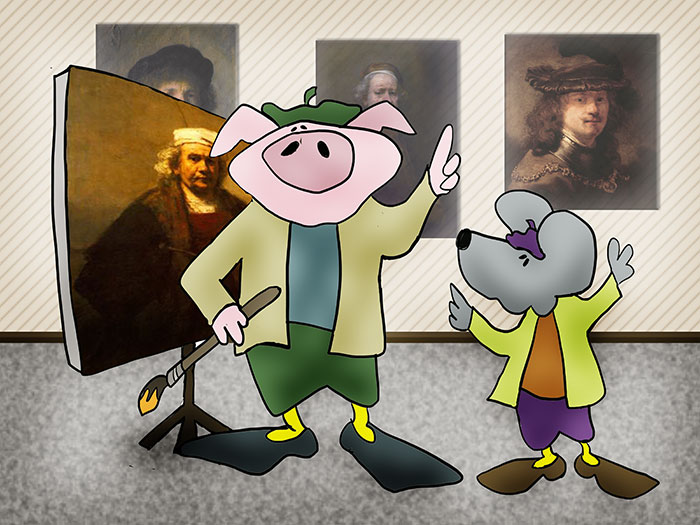He dipped the tip of his brush into the yellow paint on his palette board. Too yellow, he thought. So he smudged in a little black, red, and white — and pushed the paint in slow circles on the palette. It was now the same color as the light coming through the window. Finally, the right yellow. He continued to study, and work, paying close attention to every detail. The room on the canvas beckoned — a twisting stairway in a dark corner, with the brilliant yellow light, shining through to closed window. The old man looking down at the floor, lost in thought. A million miles away. The year was 1632, and the painting was “Lost in Meditation,” an oil on board. Rembrandt van Rijn held the brush.
He is one of my favorite artists. I simply love his paintings. The way he worked with light, and expression, are just glorious to me. Of course, he is considered to be one of the greatest painters and printmakers in European art. Probably the most important in Dutch history.
I’m not going to go into all of his life details. It was really a pretty sad life. It started out good. His parents were “modestly” well to do. It always cracks me up though. The Netherlands. The language. His Dad and Mom’s names were, respectively, Harmen Gerritszoon van Rijn and Neeltgen Willemsdochter van Zuijtbrouck. Seriously.
I remember the last time I was in Amsterdam, we ducked into a shop. I bought a glass rooster there. Anyway, they had a very cool dog in their store. A real dog. Their pet. The owners spoke decent English, thankfully. I knelt down and was petting the dog. I asked them his name. They told me, like eight times. Every time I said it, they chuckled, and would repeat it again. It sort of felt like I was saying “Trafalgar Boinks York,” but will a mouthful of marbles. I ended up just calling him Carl.
But Rembrandt. Yes, there was a time when he was pretty successful as a painter. He rolled in some decent commissions and such. But things happened. He and his wife lost three of their children in infancy. He liked to buy art, and he spent too much. He declared insolvency at one point in his life. Despite all of that, he kept creating masterpieces. Gorgeous works of art, each holding a magic all its own.
At the end of his life, he was a poor man. He died on this date, on October 4th, in 1669 in Amsterdam. Yep. And was buried as a poor man in an unknown grave. He was in a numbered ‘kerkgraf’ (grave owned by the church). Unknown, somewhere under a tombstone in the church.
And then, after twenty years, his remains were taken away and destroyed. That’s what they did in the Netherlands back then. It was customary with the remains of poor people at the time.
Such a brilliant talent, in his human body, while he was here. And then, just like that, he was no more. Gone. I saw that today was his death date. His human impermanence. Life, and then death.
Rembrandt left behind more than 600 incredible paintings. His legacy lives on.
But for all of us, our lives live on too. Everything we do affects the world around us. It truly does. Every action, word, intention, and act, makes an impact on this place. This existence. The being of us. Yes. Each thing we do, ripples out and touches someone else. There is a connectedness which continues.
And as we move through our lives and days, and minutes and seconds, we can do what is in front of us. And do it with good intention.
Our own brilliance continuing in the colors of our world.
===============
“A storyteller makes up things to help other people; a liar makes up things to help himself.”
― Daniel Wallace, The Kings and Queens of Roam
=================
“Intention is one of the most powerful forces there is. What you mean when you do a thing will always determine the outcome. The law creates the world.”
― Brenna Yovanoff, The Replacement
================
“Nothing in life is to be feared, it is only to be understood. Now is the time to understand more, so that we may fear less.”
― Marie Curie
=================
